Research on the Classification of Rail Transit Stations and Passenger Flow Patterns—A Case from Xi’an, China
Abstract
1. Introduction
1.1. Literature Review
- (1)
- Classification by station passenger flow characteristics: A related study in Beijing classified 195 stations into eight different types through the time-series clustering of metro stations’ passenger flow data [14]. A study in Shanghai classified the time series of stations based on card operation data from 288 stations, combining passenger flow and shopping district integration [15]. A related study in Chongqing utilized operational data to classify 25 stations into five classes using passenger traffic, station operations, and other transportation characteristics as classification factors [16].
- (2)
- Classification by land use and building function around the station: Related studies determined the station type by analyzing the dominant urban functional types within a certain catchment area (CA) around a station. In Shanghai, for example, a study took 23 stations in new towns as an example, used a 600 m radius as the CA, characterized the functions of the land around the stations through point-of-interest (POI) data, and classified the stations into five types [17]. In Hong Kong, POI data within the 500 m CAs around stations were extracted to categorize stations according to seven indicators of the built environment, including the land-use diversity, commercial intensity, and population. The results found that commercial, residential, tourist, and industrial land uses had the most significant influence on the station type [7].
- (3)
- Classification based on multiple indicators, such as passenger flow characteristics, surrounding urban functions, and accessibility: a study in Lisbon evaluated 50 stations based on their transportation accessibility, land use, and urban design [18]. Another study in Shanghai used POIs to classify 347 stations into five categories based on three factors: traffic characteristics, pedestrian accessibility, and comprehensive urban development [19]. A study in Ningbo combined traffic volume and land use to evaluate urban stations using metro operation data and cell phone signaling data after developing a grading system [20]. A study in Xi’an used cell phone signaling and station traffic data to classify 66 stations into six categories based on traffic characteristics and the job–housing balance, and the traffic characteristics of different types of stations were analyzed [21].
1.2. Motivation and Objective
2. Data and Methodology
2.1. Selection of the Study Area and Typical Metro Lines
2.2. Urban Rail Transit Station Classification System
2.3. Calculation of Building Functional Indices within Station CAs
2.4. Analysis of the Station Typology
2.5. Passenger Flow Data
2.5.1. Field Monitoring of Passenger Flow at Typical Stations
- Selection of Typical Stations for Different Types
- Manual Monitoring of the Passenger Flow
- Calculation of the Passenger Flow Indices
2.5.2. Validation of the Measured Data against Metro Operational Data
3. Results
3.1. Passenger Flow Characteristics of Different Types of Stations
3.1.1. Passenger Flow Characteristics in the Station Dimension
- Total Station Ridership for Six Periods
- Station Ridership in Each Different Period
- (1)
- Residential: Both types of residential stations had a moderate passenger flow and bimodal peak intensity. There were significant morning and evening peaks, and the bimodal intensity was close, with an average peak coefficient of 0.27.
- (2)
- Commercial and official: The commercial type had a large flow of passengers; there were morning and evening peaks, and the evening peak was significantly stronger than the morning peak; the evening peak coefficient was 0.32, and it was ranked second among those of all the types.
- (3)
- Industrial: The industrial type had the lowest passenger flow, but the morning and evening peaks were the most significant. For the two stations of type IV C, the terminal Matengkong embodied a significant difference; the terminal’s morning peak was significantly higher than the evening peak, and the morning peak coefficient was the highest among all of the types at 0.42. In addition, the characteristics of the changes in different time periods for the industrial type were similar to those for the residential type, but the off-peak passenger flow was significantly lower than that of the residential types.
- (4)
- Transportation-oriented: The transportation-oriented type did not have morning and evening peaks, but the passenger flow was significantly higher at 20:00, which may have been influenced by the fact that external transportation, such as urban railroads, has more arrivals in the evening.
- (5)
- Special: The two special types reflected uncertainty in both passenger flow and morning and evening peak intensities, with IV E having a large passenger flow and the morning and evening peak intensities being close to one another; IIE had a small passenger flow with only significant evening peaks; and the highest evening peak coefficient of all types of stations was 0.37. The rest of the hours had strong heterogeneity in passenger flow.
- (6)
- Integrated: The integrated type had the highest passenger flow, with only significant evening peaks and a low evening peak intensity, and the average coefficient was 0.25. In addition, the passenger flow showed a gradual increase from 8:00 to 18:00, and it significantly decreased at 20:00.
- Inbound/Outbound Flows of Stations in Each Different Period
- (1)
- Residential: There was a bimodal phenomenon for both inbound and outbound flows, but the intensity was different. IV A had a morning peak for outbound flows and an evening peak for inbound flows. This was not a typical characteristic of residential stations. This may have been because the employed population did not live on the residential land in the area of station IV A, thus resulting in the phenomenon of an imbalance between occupations and residences. II A had similar intensities for the inbound and outbound peaks in the morning and the evening, which also reflected a certain degree of imbalance between jobs and housing.
- (2)
- Commercial and official: The inbound flow only had an evening peak, and the outbound flow’s morning peak was stronger than the evening peak, which is a typical characteristic of employment-oriented access. This indicated that there were more employment flows out of the station during the morning peak, and attention should be paid to controlling the outbound flows during the morning peak and the inbound flows during the evening peak.
- (3)
- Industrial: Although the three stations had significant differences in passenger flow, they all had significant morning and evening peaks. For IV C, the terminal station Matengkong had the lowest passenger flow, and the intensity of the morning and evening peaks was close to that of IV C. II C had the highest passenger flow, and the inbound and outbound peaks were significantly stronger than the evening peaks.
- (4)
- Transportation-oriented: The outbound flow was significantly larger than the inbound flow throughout the day, and the outbound flow was close to the same at all times. There was a night peak for inbound flows at 20:00, which may have been due to the external traffic brought by the railroad being more concentrated in the evening; this part of the passenger flow through the station to transfer to the city’s internal traffic was larger. Therefore, for hub-type stations, the transfer passenger flow from external traffic to internal traffic should be controlled at 20:00, which is the peak hour in the evening.
- (5)
- Special type: For inbound flows, the evening peak was more significant than the morning peak. For outbound flows, the morning peak was more significant than the evening peak. This was a significant characteristic of employment-oriented traffic. This was caused by the greater number of land uses attracting employment in this type of area.
- (6)
- Integrated: The outbound flows had a double morning and evening peak, while the inbound flows had only an evening peak, and the evening peak occurred earlier. This was characterized by employment-oriented passenger flows. In comparison with the special and commercial and official types, this type had no morning peaks in the inbound flows, and the double-peak phenomenon occurred in the outbound flows. This indicated that this type was characterized by a high proportion of commercial and other public service functions, with the morning peak attracting employment and the evening peak attracting consumers.
3.1.2. Passenger Flow Characteristics in the Exit Dimension
- Total Ridership at Different Exits in Six Periods
- Total Ridership at Exits in Each Different Period
- (1)
- Residential: Although there were significant differences in the passenger flows at each exit of the two types, the spatial and temporal characteristics were close to each other, and there were significant morning and evening peaks at each exit.
- (2)
- Commercial and official: There were significant differences in the total passenger flows and the spatiotemporal characteristics of the exits. There was significant bimodality in the morning and evening at only two exits, non-significant bimodal characteristics at three exits, and significant evening peaks at only one exit. This was due to the different land-use functions of the parcels of land connected to the exits. In addition, although Figure 9 shows that the evening peak was stronger than the morning peak in the station dimension, there were still certain exits (B) where the morning peak was stronger than the evening peak.
- (3)
- Industrial: There were significant differences in the total passenger flows at each exit, but the spatiotemporal characteristics were close to each other, with significant bimodal phenomena at all exists. This was similar to the findings for the residential type, but the passenger flows in off-peak hours were significantly lower than those of the residential type. Notably, the departure station Matengkong had uneven passenger flows at all exits, with one exit having significantly high passenger flows and a great intensity of morning and evening peaks. This can be managed operationally by guiding passenger flows to relieve congested exits. The morning and evening peaks at IV C (Zaoyuan) were close, and the intensity of the morning peak was stronger than that of the evening peak at all exits in II C (Kaiyuanmen).
- (4)
- Transportation-oriented: Although the station ridership was close in each period (Figure 9), there was a significant difference in the spatiotemporal characteristics of the morning and evening peaks at each exit.
- (5)
- Special: The overall spatiotemporal characteristics of the two types of passenger flows were close to each other, and there were morning and evening peaks at each exit, but the evening peak of the II E type was stronger than the morning peak, and the intensities of the morning and evening peaks of the IV E type were close to each other. Both types had individual exits with significantly lower passenger flows and insignificant bimodal phenomena.
- (6)
- Integrated: The passenger flow characteristics of the IV G and II G types were close in the station dimension, but there were significant differences in the exit dimension. There were significant differences in the spatiotemporal characteristics of all the exits of the IV G type, and the morning and evening peak characteristics were different. The passenger flows and spatiotemporal characteristics of the II G type were close to each other at all exits except for exit D, which was directly connected to a commercial complex in Xiaozhai. This suggests that for integrated stations, the focus should be on controlling exits that connect to large commercial facilities.
- Inbound/Outbound Flows at Exits in Each Different Period
- (1)
- Residential: There were significant differences between the two types. The inbound flows in the IV A type were more significant at the evening peak at all exits, which was consistent with the station dimension shown in Figure 10. However, there was uncertainty in the outbound flow, and the evening peak was stronger than the morning peak at exit B for the outbound flow. The remaining three exits were consistent with the station dimension shown in Figure 10, with the morning peak being stronger than the evening peak. For II A, there were significant differences in the two exits, with the morning peak being stronger than the evening peak at exit B and the opposite at exit D, which was different from the station dimension shown in Figure 10.
- (2)
- Commercial and official: All exits had stronger evening peaks than morning peaks for inbound flows, and there were complexities and uncertainties in the outbound flow. Exits A, B, and C had lower traffic and stronger morning peaks than evening peaks. Exit D had close outbound traffic in all time periods. Exit E had close morning and evening peaks, and F had only morning peaks. This indicated that the building functions connected to different exits had a significant impact on passenger flows, and management needs to pay attention to the key exits.
- (3)
- Industrial: Three stations were close to each other in terms of the morning and evening peaks at all exits. II C was the most stable, with the morning peaks being stronger than the evening peaks at all exits, and there was uncertainty in the morning and evening peaks at all exits in IV C.
- (4)
- Transportation-oriented: Compared with the other types, this type had the most significant difference in passenger flow characteristics among the exits. Only one exit had an inbound evening peak at 20:00. The inbound and outbound flows of each exit were close to each other, and management needs to implement control at 20:00 in the evening.
- (5)
- Special: The inbound peaks of IV E were uncertain, but the outbound peaks were stronger than the evening peaks. The outbound peaks of IIE had the same spatiotemporal characteristics, and there was only a significant evening peak. There was uncertainty in the morning and evening peak characteristics at all inbound exits.
- (6)
- Integrated: The spatiotemporal characteristics of the inbound flows of the two types were close, and only significant evening peaks were manifested for inbound flows. However, for the outbound flows, there were significant morning peaks at two exits and only evening peaks at one exit at IV G. There was a significant evening peak at the exit that directly connected to a commercial complex at II G, and the remaining five exits exhibited stronger morning than evening peaks, which was the opposite of what is shown in Figure 12. This suggested that the multiple connections of integrated stations to commercial complexes have a significant impact on the overall passenger flow at these stations.
3.2. Analysis of the Correlation between Passenger Flows and the Characteristics of the Built Environment in CAs
4. Discussion
5. Conclusions
Author Contributions
Funding
Data Availability Statement
Conflicts of Interest
References
- Sun, L.; Chen, J.; Li, Q.; Huang, D. Dramatic uneven urbanization of large cities throughout the world in recent decades. Nat. Commun. 2020, 11, 5366. [Google Scholar] [CrossRef] [PubMed]
- Pang, L.; Jiang, Y.; Wang, J.; Qiu, N.; Xu, X.; Ren, L.; Han, X. Research of Metro Stations with Varying Patterns of Ridership and Their Relationship with Built Environment, on the Example of Tianjin, China. Sustainability 2023, 15, 9533. [Google Scholar] [CrossRef]
- Han, B.M.; Xi, Z.; Sun, Y.J.; Lu, F.; Niu, C.Y.; Wang, C.X.; Xu, K.L.; Yao, Y.F. Statistical analysis of urban rail transit operation in the world in 2022: A review. Urban Rapid Rail Transit 2023, 36, 5–11. [Google Scholar]
- Su, S.L.; Zhao, C.; Zhou, H.; Li, B.Z.; Kang, M.J. Unraveling the relative contribution of TOD structural factors to metro ridership: A novel localized modeling approach with implications on spatial planning. J. Transp. Geogr. 2022, 100, 103308. [Google Scholar] [CrossRef]
- Hu, J.; Chen, J.; Li, P.; Yan, J.; Wang, H. Systematic Review of Socially Sustainable and Community Regeneration: Research Traits, Focal Points, and Future Trajectories. Buildings 2024, 14, 881. [Google Scholar] [CrossRef]
- Lyu, G.; Bertolini, L.; Pfeffer, K. Developing a TOD typology for Beijing metro station areas. J. Transp. Geogr. 2016, 55, 40–50. [Google Scholar] [CrossRef]
- Yu, Z.; Zhu, X.; Liu, X. Characterizing metro stations via urban function: Thematic evidence from transit-oriented development (TOD) in Hong Kong. J. Transp. Geogr. 2022, 99, 103299. [Google Scholar] [CrossRef]
- Sung, H.; Oh, J.T. Transit-oriented development in a high-density city: Identifying its association with transit ridership in Seoul, Korea. Cities 2011, 28, 70–82. [Google Scholar] [CrossRef]
- Jiang, Y.S.; Yu, G.S.; Hu, L.; Li, Y. Refined classification of urban rail transit stations based on clustered station’s passenger traffic flow features. J. Transp. Syst. Eng. Inf. Technol. 2022, 22, 106–112. [Google Scholar] [CrossRef]
- Lu, Y.; Wen, X.R.; Liu, M.; Yu, H. A Review on the functional orientation of rail station regional planning based on typology. Urban Dev. Stud. 2023, 30, 28–31. [Google Scholar]
- Chen, J.; Pellegrini, P.; Yang, Z.; Wang, H. Strategies for Sustainable Urban Renewal: Community-Scale GIS-Based Analysis for Densification Decision Making. Sustainability 2023, 15, 7901. [Google Scholar] [CrossRef]
- Singh, Y.J.; Fard, P.; Zuidgeest, M.; Brussel, M.; Maarseveen, M.v. Measuring transit oriented development: A spatial multi criteria assessment approach for the City Region Arnhem and Nijmegen. J. Transp. Geogr. 2014, 35, 130–143. [Google Scholar] [CrossRef]
- Bertolini, L. Nodes and places: Complexities of railway station redevelopment. Eur. Plan. Stud. 1996, 4, 331–345. [Google Scholar] [CrossRef]
- Yin, Q.; Meng, B.; Zhang, L.Y.; Bin, M.; Liying, Z. Classification of subway stations in Beijing based on passenger flow characteristics. Prog. Geogr. 2016, 35, 126–134. [Google Scholar] [CrossRef]
- Zhang, J.W.; Li, K.L.; Guo, Z.C.; Wang, C.B. Grading research of subway stations based on traffic data analysis. J. Donghua Univ. (Nat. Sci.) 2018, 44, 652–657. [Google Scholar] [CrossRef]
- Dong, Y.Z. Grade Evaluation of Urban Rail Transit Stations and Method for Grading of Regional Stations. Urban Rapid Rail Transit 2023, 36, 146–151. [Google Scholar]
- Zhang, L.; Hou, P.; Qiang, D. Transit-Oriented Development in New Towns: Identifying Its Association with Urban Function in Shanghai, China. Buildings 2022, 12, 1394. [Google Scholar] [CrossRef]
- Vale, D.S.; Viana, C.M.; Pereira, M. The extended node-place model at the local scale: Evaluating the integration of land use and transport for Lisbon’s subway network. J. Transp. Geogr. 2018, 69, 282–293. [Google Scholar] [CrossRef]
- Qiang, D.; Zhang, L.; Huang, X. Quantitative Evaluation of TOD Performance Based on Multi-Source Data: A Case Study of Shanghai. Front. Public Health 2022, 10, 820694. [Google Scholar] [CrossRef]
- Yang, L.; Song, X.Y. TOD Typology Based on Urban Renewal: A Classification of Metro Stations for Ningbo City. Urban Rail Transit 2021, 7, 240–255. [Google Scholar] [CrossRef]
- Feng, H.; Chen, Y.; Wu, J.; Zhao, Z.; Wang, Y.; Wang, Z. Urban Rail Transit Station Type Identification Based on “Passenger Flow—Land Use—Job-Housing”. Sustainability 2023, 15, 15103. [Google Scholar] [CrossRef]
- An, D.; Tong, X.; Liu, K.; Chan, E.H.W. Understanding the impact of built environment on metro ridership using open source in Shanghai. Cities 2019, 93, 177–187. [Google Scholar] [CrossRef]
- Preis, T.; Zhong, C.; Batty, M.; Manley, E.; Wang, J.; Wang, Z.; Chen, F.; Schmitt, G. Variability in Regularity: Mining Temporal Mobility Patterns in London, Singapore and Beijing Using Smart-Card Data. PLoS ONE 2016, 11, e0149222. [Google Scholar] [CrossRef]
- Ren, L.J.; Yun, Y.X.; Quan, H.Y. Study on Classification and Characteristics of Urban Rail Transit Station Based on Node-Place Model: Empirical Analysis and Experience Enlightenment of Singapore. Urban Plan. Int. 2016, 31, 109–116. [Google Scholar]
- Ministry of Housing and Urban-Rural Development of the People’s Republic of China. Guidelines for Planning and Design of Areas along Urban Railways; Ministry of Housing and Urban-Rural Development of the People’s Republic of China: Beijing, China, 2015; p. 7. [Google Scholar]
- Urban Planning Society of China. Guidelines for Space Planning and Design of Facilities around Urban Rail Transit Station; Urban Planning Society of China: Beijing, China, 2021; p. 16. [Google Scholar]
- Xi’an 2022 Statistical Yearbook. Available online: http://tjj.xa.gov.cn/tjnj/2022/zk/indexch.htm (accessed on 24 January 2024).
- Xi’an Metro Official Homepage. Available online: https://www.xianrail.com/#/index (accessed on 24 January 2024).
- Xi’an Metro Statistics. Available online: https://metrodb.org/index/xian.html (accessed on 24 January 2024).
- Zhang, X.; Sun, Y.; Luan, X. Regulation flexibility and legitimacy building in governing intercity railways: The polymorphous role of the Chinese provincial government. J. Urban Aff. 2023, 1–16. [Google Scholar] [CrossRef]
- Xi’an Bureau of Statistics. Bulletin of Main Data of the Seventh National Population Census of Xi’an City; Xi’an Bureau of Statistics: Xi’an, China, 2021; p. 1. [Google Scholar]
- Xi’an City Planning Design and Research Institute. Annual Report on Urban Transportation Development in Xi’an, 2022; Xi’an Municipal Bureau of Natural Resources and Planning: Xi’an, China, 2023; pp. 11–12. [Google Scholar]
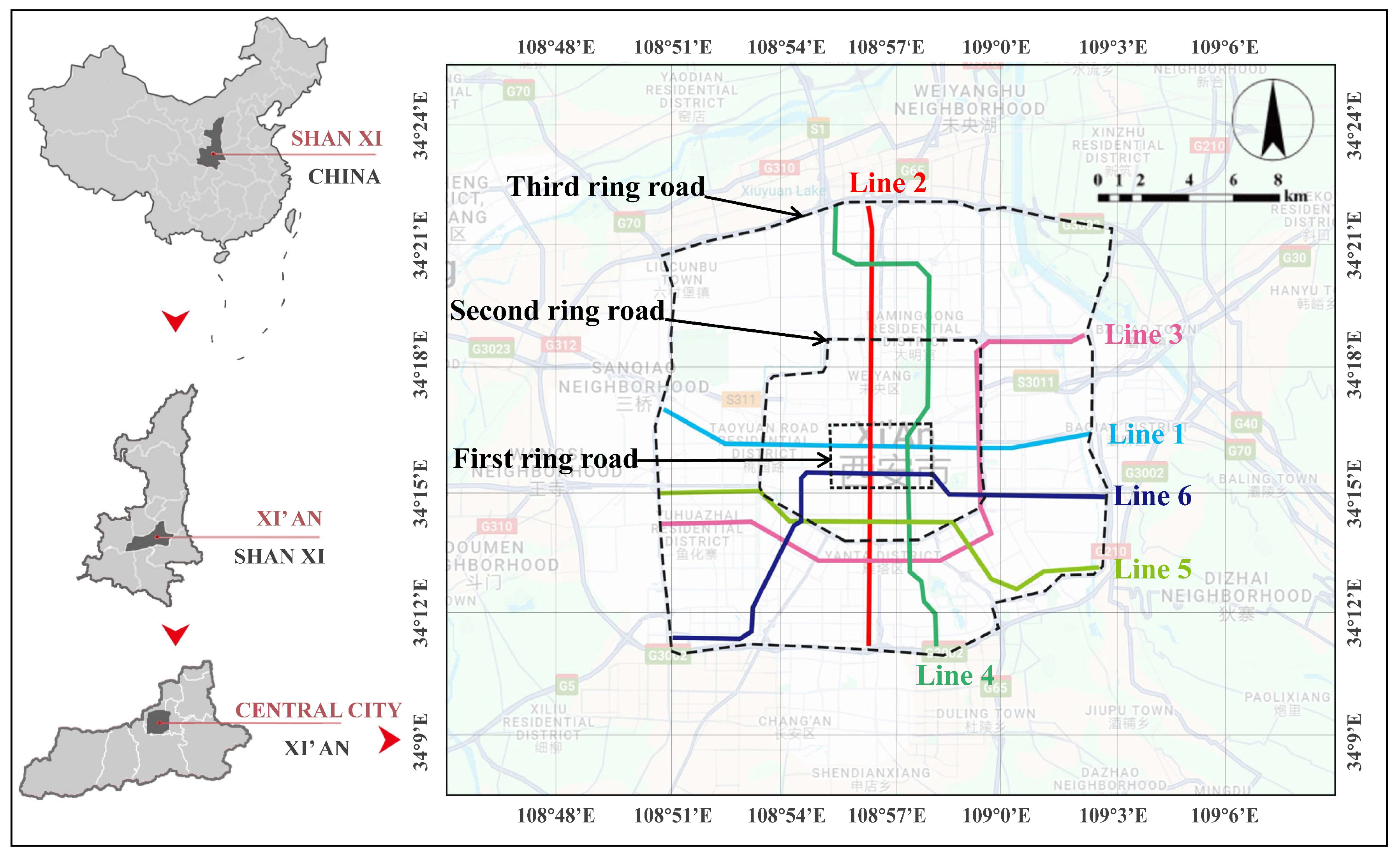
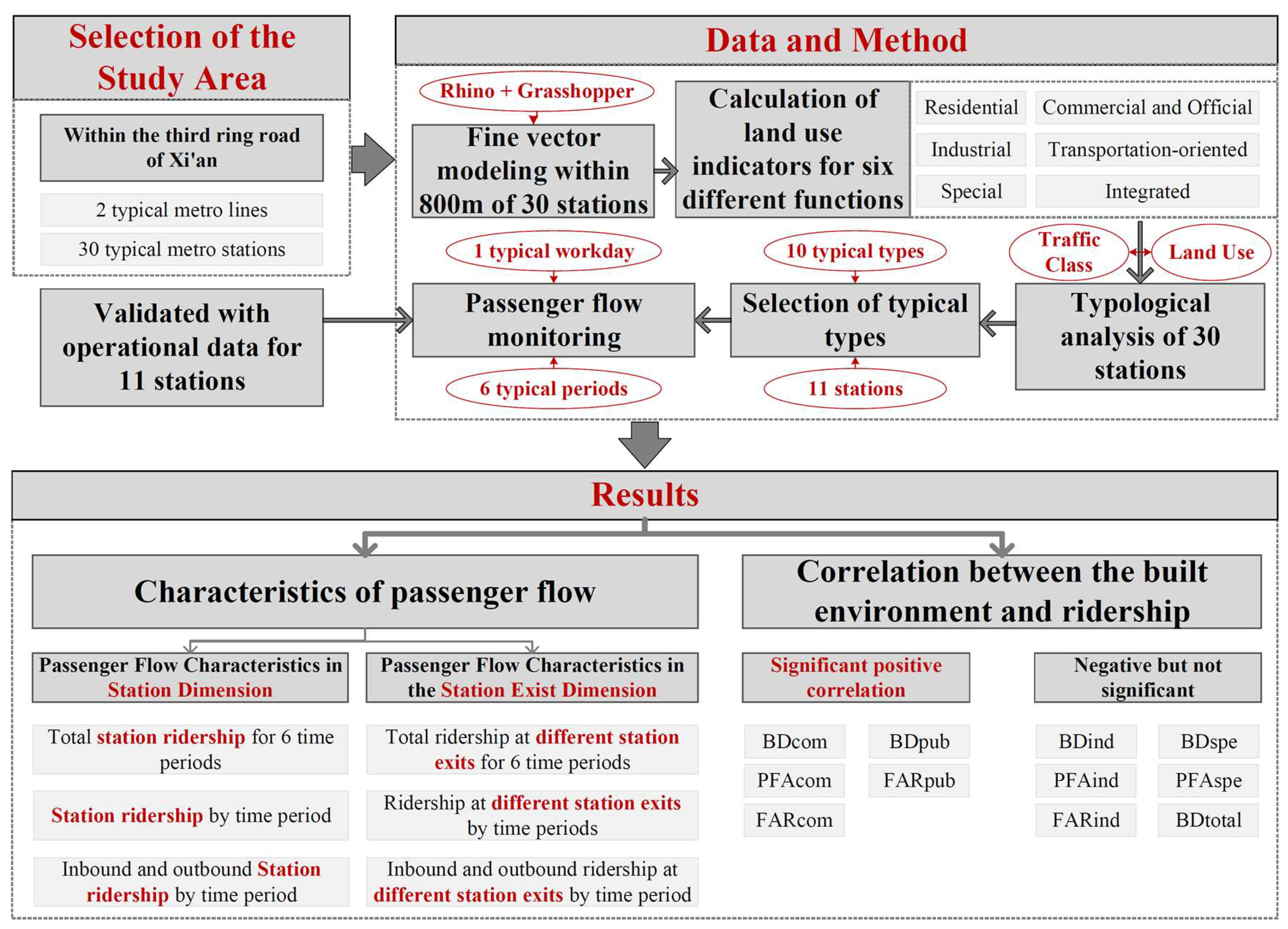
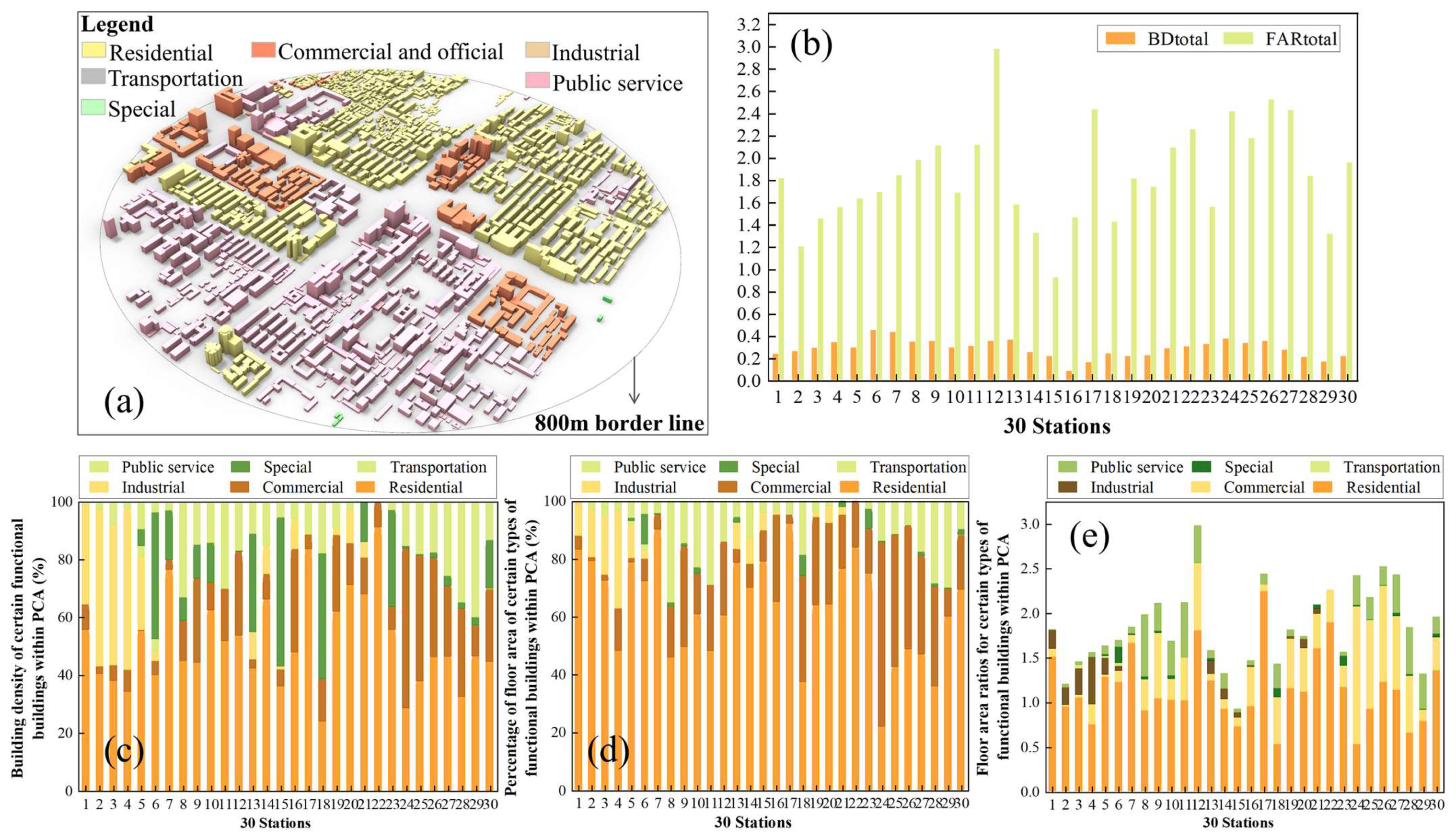
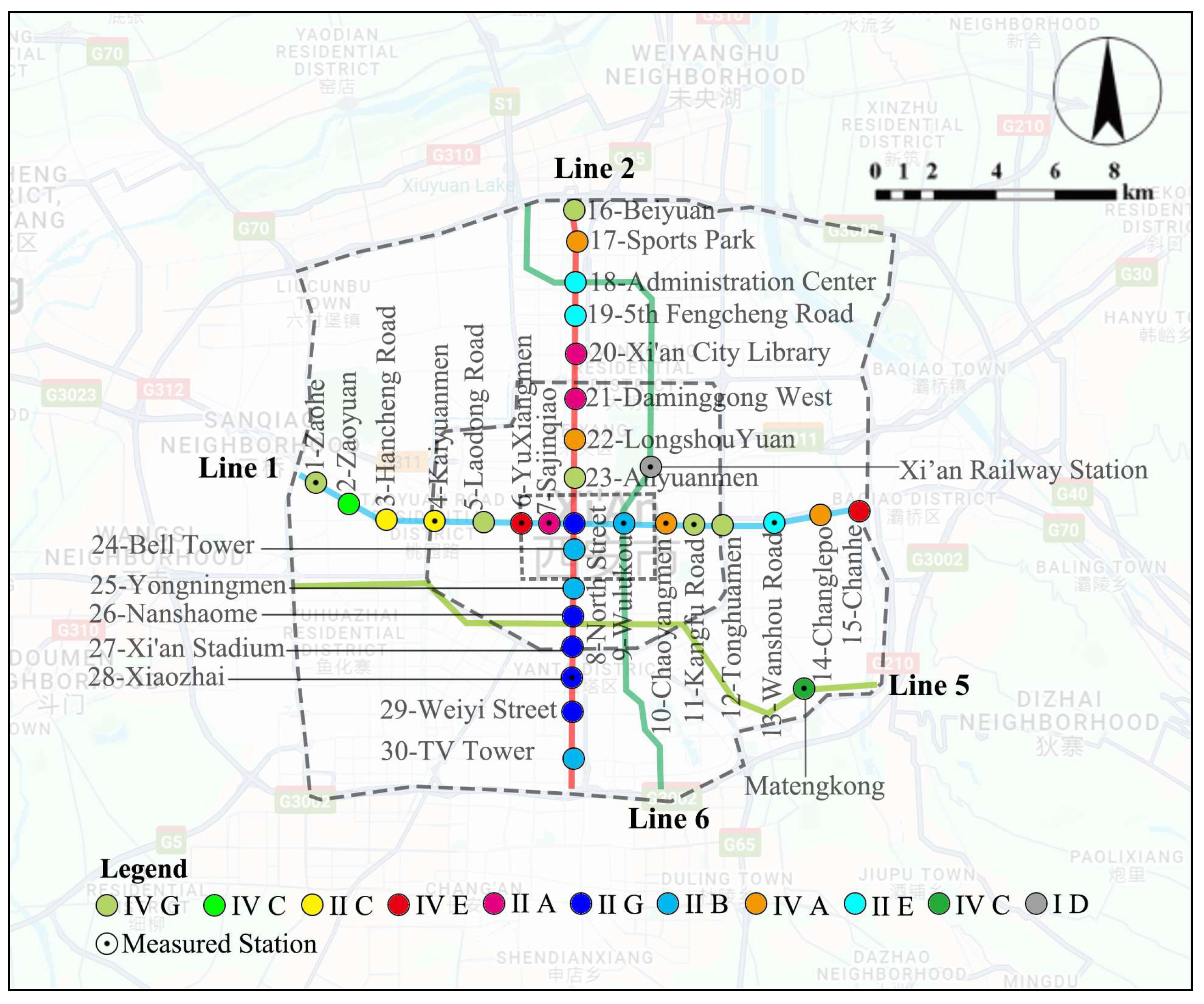
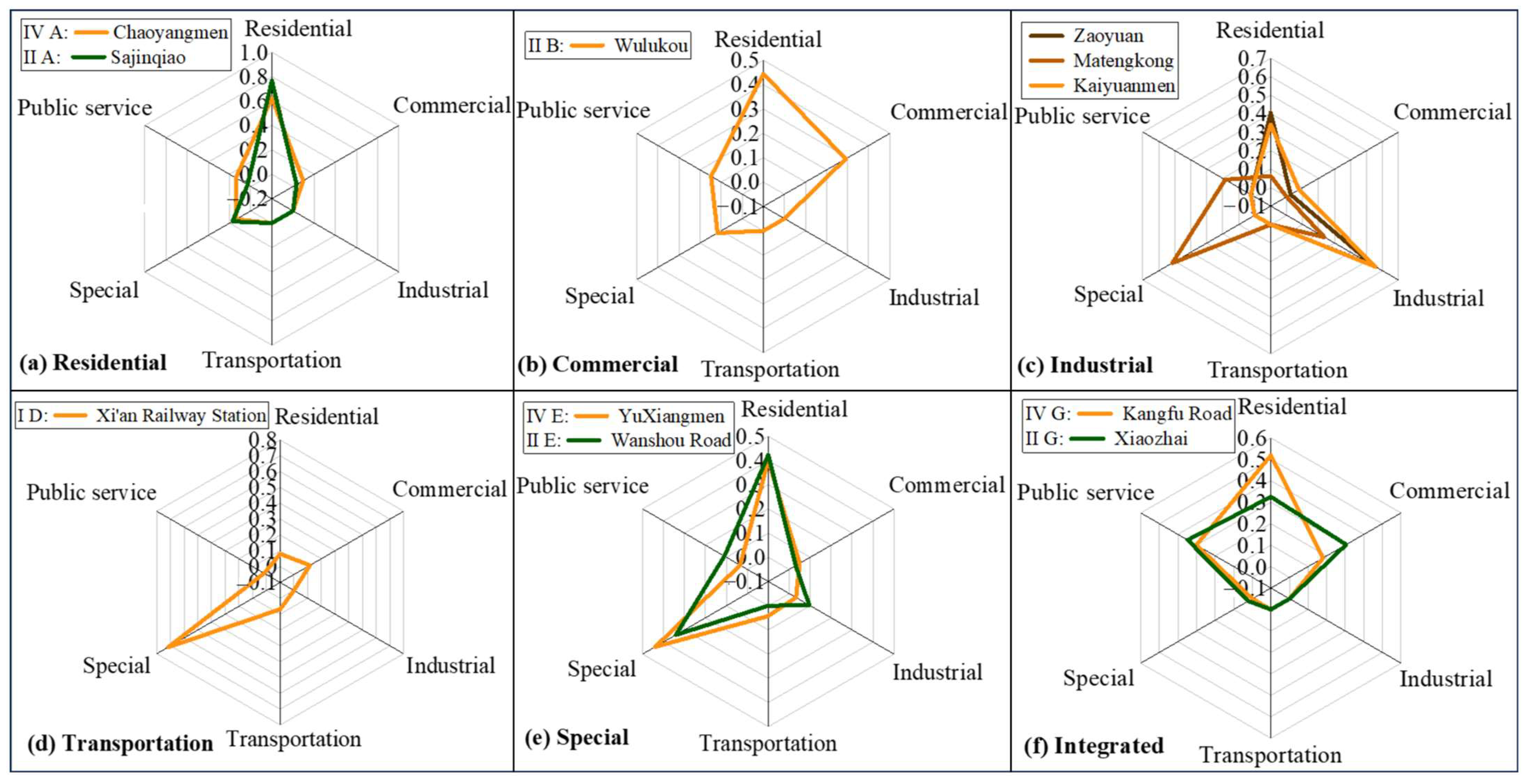

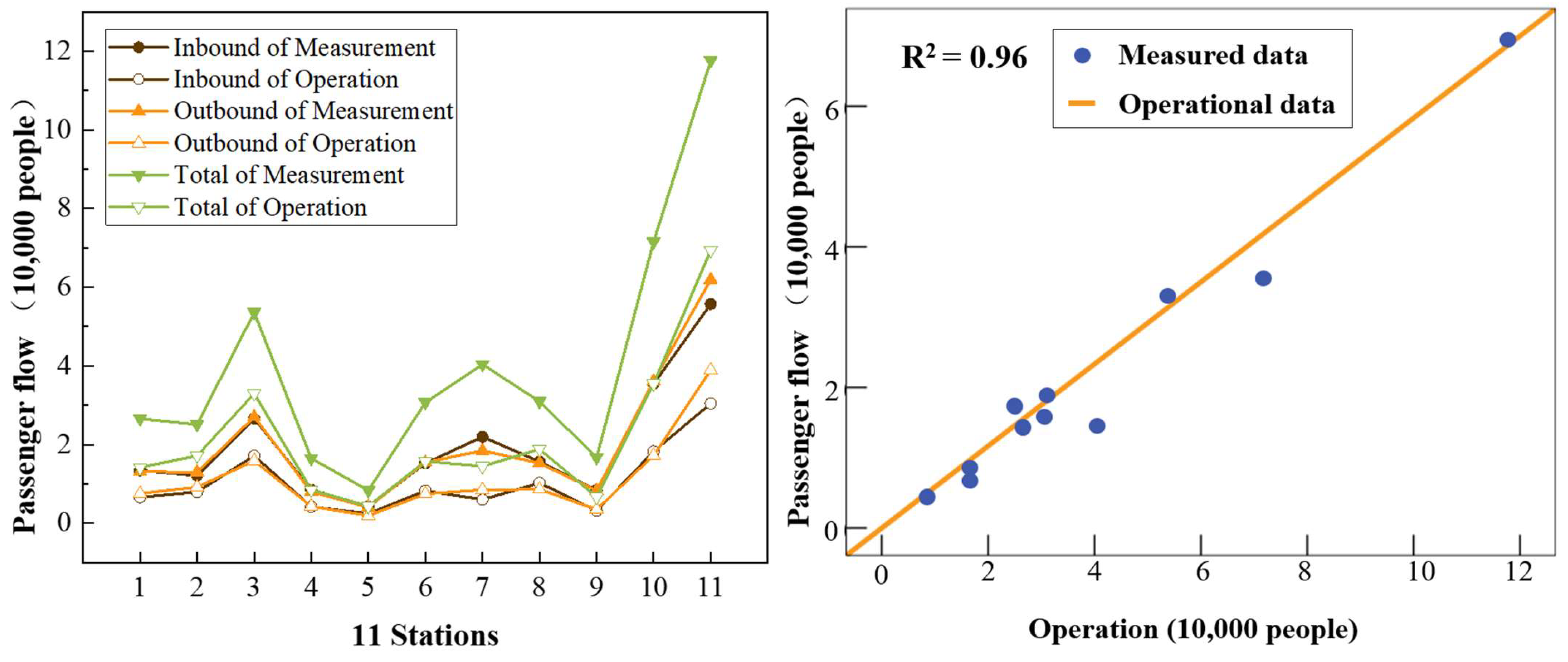
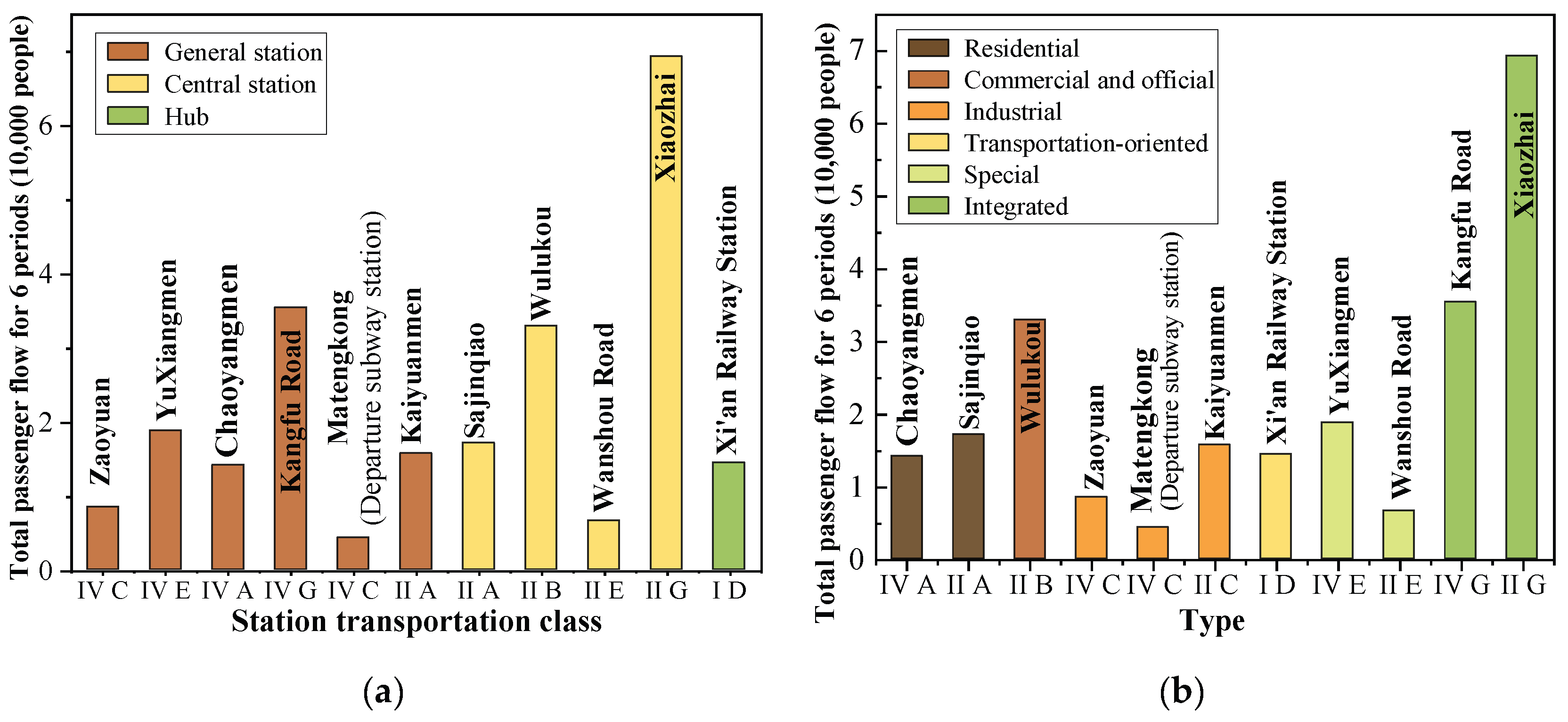



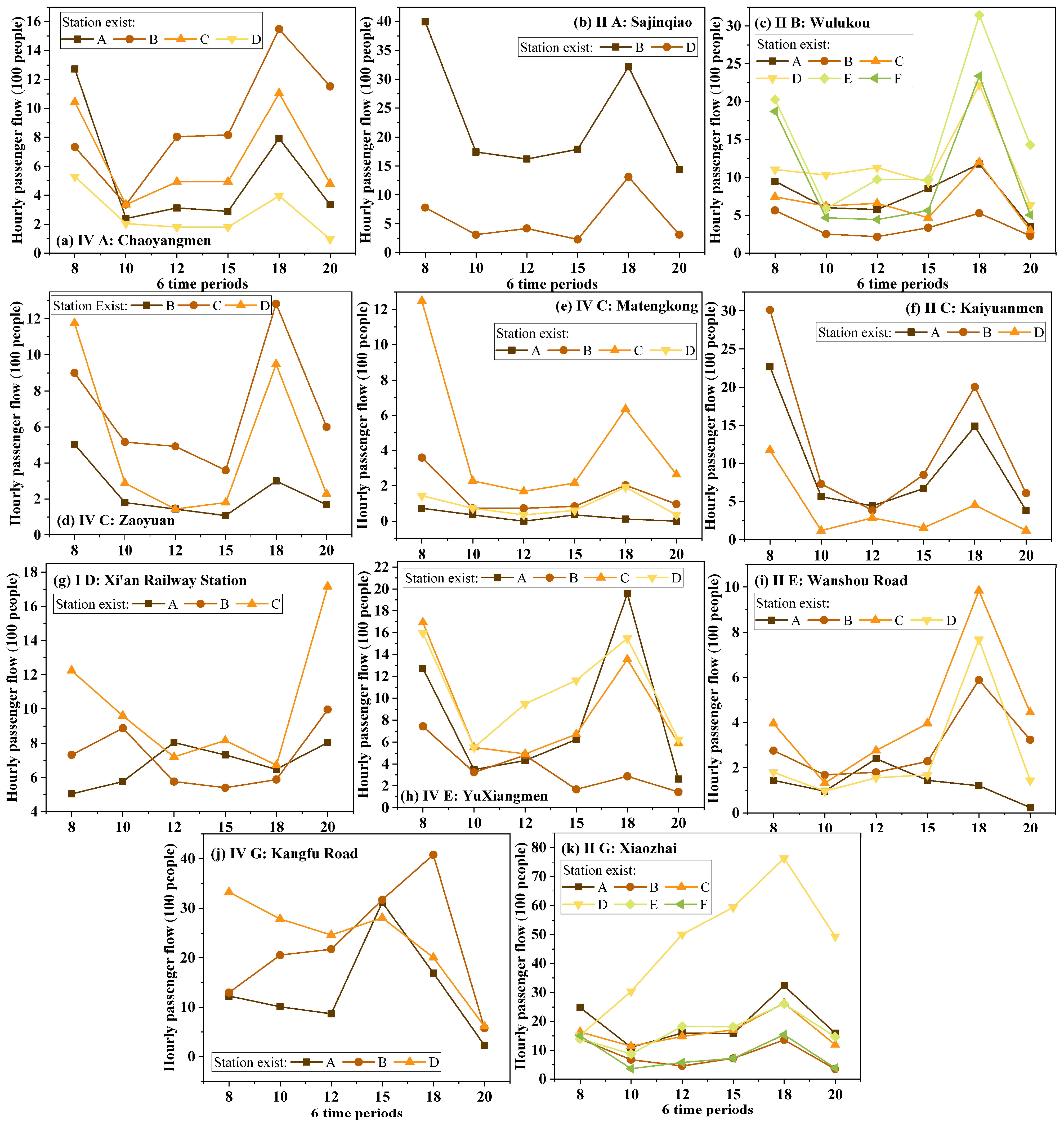
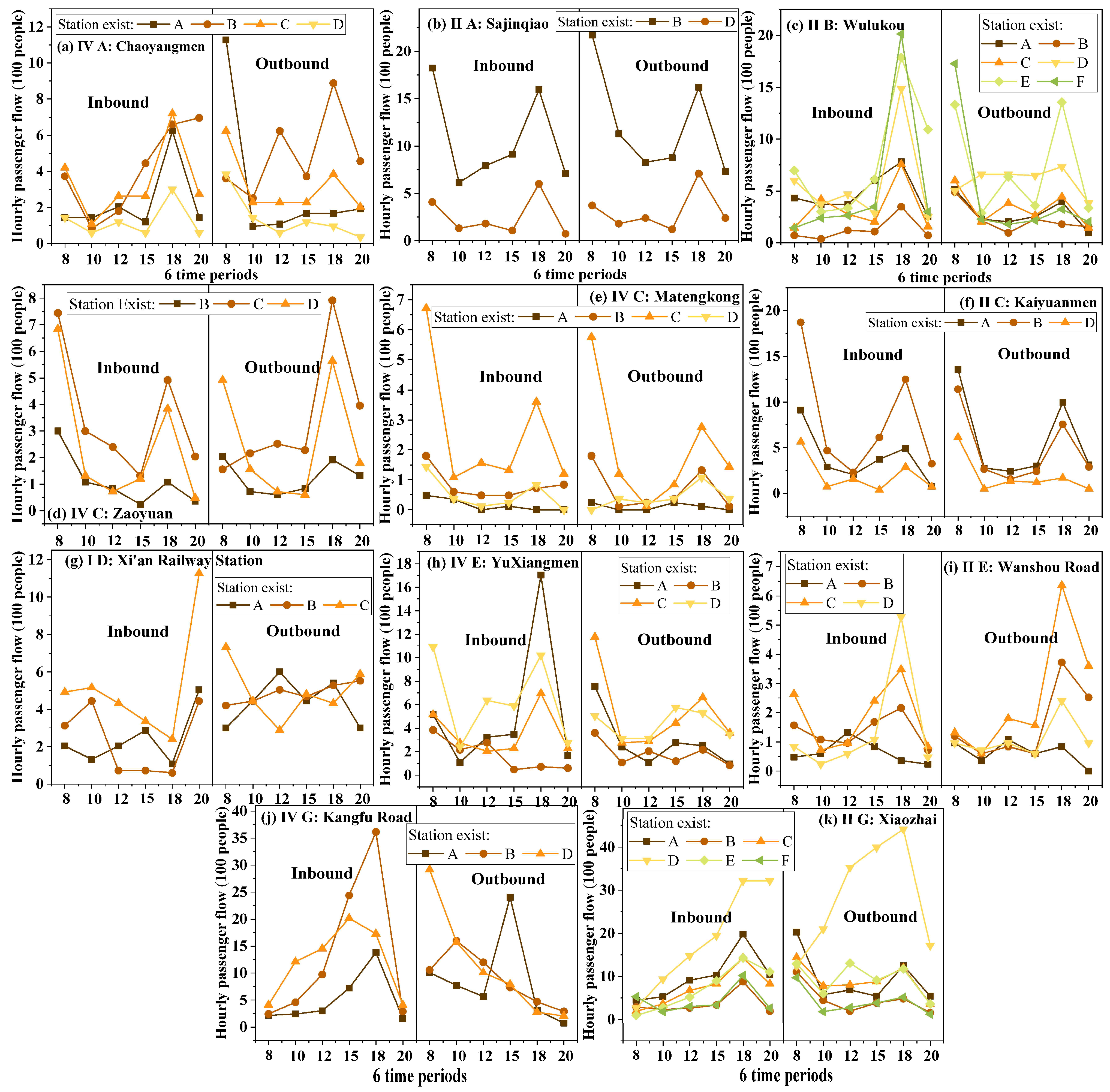

| Types | Residential (A) | Commercial and Official (B) | Industrial (C) | Transportation (D) | Special (E) | Public Service (F) | Integrated (G) |
|---|---|---|---|---|---|---|---|
| Hub (I) | I A | I B | I C | I D | I E | I F | I G |
| Central (II) | II A | II B | II C | II D | II E | II F | II G |
| Cluster (III) | III A | III B | III C | III D | III E | III F | III G |
| Normal (IV) | IV A | IV B | IV C | IV D | IV E | IV F | IV G |
| (Unit)/Built-Up Indices (Abbreviations) | Description or Calculation Method |
|---|---|
| (%)/Building density of certain types of functional buildings within the CA (BDcertain type *1) | Sum of the base areas of certain types of functional buildings within the CA/the area of the CA |
| (%)/Percentage of floor area of certain types of functional buildings within the CA (PFAcertain type *1) | Gross floor area of certain types of functional buildings within the CA/total floor area within the CA |
| (null)/Floor area ratios for certain types of functional buildings within the CA (FARcertain type *1) | Gross floor area of certain types of functional buildings within the CA/the area of the CA |
| (%)/Total building density of the CA (BDtotal *2) | Total base areas of all buildings within the CA/the area of the CA |
| (null)/Total floor area ratio of the CA (FARtotal *2) | Total floor area within the CA/the area of the CA |
| (Unit)/Passenger Flow Indices | Definition and Calculation |
|---|---|
| (person trips)/Total station ridership for 6 periods | The sum of the measured number of passengers at a station for 6 typical periods |
| (person trips)/Station ridership in each different period | Measured number of passengers at a station in a different typical period |
| (person trips)/Inbound/outbound stations in each different period | Measured number of passengers entering/exiting a station in a different typical period |
| (person trips)/Total ridership at an exit in 6 periods | The sum of the measured number of passengers at an exit of a station for 6 typical periods |
| (person trips)/Total ridership at an exit in each different period | Measured number of passengers at an exit of a station in a different typical period |
| (person trips)/Inbound/outbound flow at an exit in each different period | Measured number of passengers entering/exiting an exit of a station in a different typical period |
Disclaimer/Publisher’s Note: The statements, opinions and data contained in all publications are solely those of the individual author(s) and contributor(s) and not of MDPI and/or the editor(s). MDPI and/or the editor(s) disclaim responsibility for any injury to people or property resulting from any ideas, methods, instructions or products referred to in the content. |
© 2024 by the authors. Licensee MDPI, Basel, Switzerland. This article is an open access article distributed under the terms and conditions of the Creative Commons Attribution (CC BY) license (https://creativecommons.org/licenses/by/4.0/).
Share and Cite
Chen, L.; Chen, Y.; Wang, Y.; Li, Y. Research on the Classification of Rail Transit Stations and Passenger Flow Patterns—A Case from Xi’an, China. Buildings 2024, 14, 1068. https://doi.org/10.3390/buildings14041068
Chen L, Chen Y, Wang Y, Li Y. Research on the Classification of Rail Transit Stations and Passenger Flow Patterns—A Case from Xi’an, China. Buildings. 2024; 14(4):1068. https://doi.org/10.3390/buildings14041068
Chicago/Turabian StyleChen, Li, Yuan Chen, Yupeng Wang, and Ying Li. 2024. "Research on the Classification of Rail Transit Stations and Passenger Flow Patterns—A Case from Xi’an, China" Buildings 14, no. 4: 1068. https://doi.org/10.3390/buildings14041068
APA StyleChen, L., Chen, Y., Wang, Y., & Li, Y. (2024). Research on the Classification of Rail Transit Stations and Passenger Flow Patterns—A Case from Xi’an, China. Buildings, 14(4), 1068. https://doi.org/10.3390/buildings14041068







